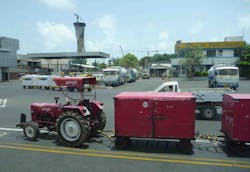Introducing New Technology On the Ramp Has Its Challenges
Travelling through India this month, I noticed farm tractors used on the ramp as baggage tugs at several airports. It seemed like a cost-effective, adaptive use of readily available equipment re-purposed from the fields to work on the ramp.
Instead of importing equipment from abroad, it made sense for airlines to use Indian-made machinery. And farm tractors can haul quite a load; they’re reliable, easy to maintain and there’s a ready labor source to operate them.
Intrigued by this use of farm tractors, I started looking into the issue more and learned that there is a significant effort under way to replace these diesel-fueled tractors with energy-efficient, emission-free electric GSE.
It certainly seemed like a good idea, what with climate change and the pressure to reduce emissions especially in emerging economies. But as I looked into the issue further on the Internet, I came upon a number of articles in Indian newspapers that described a situation that could be a lesson for all of us on introducing new technology. It happened in India, but it could happen anywhere if we’re not careful – think of all the problems the then new airport in Denver had with its high-tech baggage system.
According to the articles, a new terminal at Chennai Airport had to be temporarily closed because the new electric tugs could not negotiate the steep incline leading to the baggage handling area. And the farm tractors that could were setting off the smoke alarms with their emissions.
About the Author

John Goglia
John Goglia has 40+ years experience in the aviation industry. He was the first NTSB member to hold an FAA aircraft mechanic's certificate. He can be reached at [email protected].
John Goglia is an independent aviation safety consultant and Adjunct Professor at Vaughn College of Aeronautics and Technology and regular monthly columnist for four aviation trade publications. He was an airline mechanic for more than 30 years. He has co-authored two text books (Safety Management Systems in Aviation, Ashgate Publishing 2009 and Implementation of Safety Management Systems in Aviation, Ashgate Publishing 2011).
